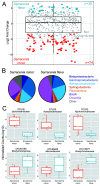Selective Bacterial Community Enrichment between the Pitcher Plants Sarracenia minor and Sarracenia flava
- PMID: 34817222
- PMCID: PMC8612160
- DOI: 10.1128/Spectrum.00696-21
Selective Bacterial Community Enrichment between the Pitcher Plants Sarracenia minor and Sarracenia flava
Abstract
The interconnected and overlapping habitats present in natural ecosystems remain a challenge in determining the forces driving microbial community composition. The cuplike leaf structures of some carnivorous plants, including those of the family Sarraceniaceae, are self-contained ecological habitats that represent systems for exploring such microbial ecology questions. We investigated whether Sarracenia minor and Sarracenia flava cultivate distinct bacterial communities when sampled at the same geographic location and time. This sampling strategy eliminates many abiotic environmental variables present in other studies that compare samples harvested over time, and it could reveal biotic factors driving the selection of microbes. DNA extracted from the decomposing detritus trapped in each Sarracenia leaf pitcher was profiled using 16S rRNA amplicon sequencing. We identified a surprising amount of bacterial diversity within each pitcher, but we also discovered bacteria whose abundance was specifically enriched in one of the two Sarracenia species. These differences in bacterial community representation suggest some biotic influence of the Sarracenia plant on the bacterial composition of their pitchers. Overall, our results suggest that bacterial selection due to factors other than geographic location, weather, or prey availability is occurring within the pitchers of these two closely related plant species. This indicates that specific characteristics of S. minor and S. flava may play a role in fostering distinct bacterial communities. These confined, naturally occurring microbial ecosystems within Sarracenia pitchers may provide model systems to answer important questions about the drivers of microbial community composition, succession, and response to environmental perturbations. IMPORTANCE This study uses amplicon sequencing to compare the bacterial communities of environmental samples from the detritus of the leaf cavities of Sarracenia minor and Sarracenia flava pitcher plants. We sampled the detritus at the same time and in the same geographic location, eliminating many environmental variables present in other comparative studies. This study revealed that different species of Sarracenia contain distinct bacterial members within their pitchers, suggesting that these communities are not randomly established based on environmental factors and the prey pool but are potentially enriched for by the plants' chemical or physical environment. This study of these naturally occurring, confined microbial ecosystems will help further establish carnivorous pitcher plants as a model system for answering important questions about the development and succession of microbial communities.
Keywords: Sarracenia; bacterial genomics; microbial communities; microbiome; pitcher plants.
Figures


Similar articles
-
The carnivorous pale pitcher plant harbors diverse, distinct, and time-dependent bacterial communities.Appl Environ Microbiol. 2010 Mar;76(6):1851-60. doi: 10.1128/AEM.02440-09. Epub 2010 Jan 22. Appl Environ Microbiol. 2010. PMID: 20097807 Free PMC article.
-
Bacterial diversity in three distinct sub-habitats within the pitchers of the northern pitcher plant, Sarracenia purpurea.FEMS Microbiol Ecol. 2012 Mar;79(3):555-67. doi: 10.1111/j.1574-6941.2011.01240.x. Epub 2011 Nov 21. FEMS Microbiol Ecol. 2012. PMID: 22092381
-
Arthropod prey type drives decomposition rates and microbial community processes.Appl Environ Microbiol. 2024 Jul 24;90(7):e0039424. doi: 10.1128/aem.00394-24. Epub 2024 Jun 25. Appl Environ Microbiol. 2024. PMID: 38916291 Free PMC article.
-
Traps of carnivorous pitcher plants as a habitat: composition of the fluid, biodiversity and mutualistic activities.Ann Bot. 2011 Feb;107(2):181-94. doi: 10.1093/aob/mcq238. Epub 2010 Dec 15. Ann Bot. 2011. PMID: 21159782 Free PMC article. Review.
-
Biofilms in lab and nature: a molecular geneticist's voyage to microbial ecology.Int Microbiol. 2010 Mar;13(1):1-7. doi: 10.2436/20.1501.01.105. Int Microbiol. 2010. PMID: 20890834 Review.
Cited by
-
Assembling microbial communities: a genomic analysis of a natural experiment in neotropical bamboo internodes.PeerJ. 2022 Sep 16;10:e13958. doi: 10.7717/peerj.13958. eCollection 2022. PeerJ. 2022. PMID: 36132220 Free PMC article.
References
-
- Antwis RE, Griffiths SM, Harrison XA, Aranega-Bou P, Arce A, Bettridge AS, Brailsford FL, de Menezes A, Devaynes A, Forbes KM, Fry EL, Goodhead I, Haskell E, Heys C, James C, Johnston SR, Lewis GR, Lewis Z, Macey MC, McCarthy A, McDonald JE, Mejia-Florez NL, O’Brien D, Orland C, Pautasso M, Reid WDK, Robinson HA, Wilson K, Sutherland WJ. 2017. Fifty important research questions in microbial ecology. FEMS Microbiol Ecol 93:11512. doi:10.1093/femsec/fix044. - DOI - PubMed
Publication types
MeSH terms
Grants and funding
LinkOut - more resources
Full Text Sources

